A Paipo
Interview with Dave Andrews
June 3-July 15, 2016 - Grafton, Australia
E-mail questions by Bob Green
A bellyboard became the perfect surfcraft for Dave who
lived several hours inland from Australia's NSW north coast. His board
was stored in an old family caravan since the 1970s. In 2014, the board
saw the light of day again when it came out of storage when the van was
cleaned out to sell to a restorer. The board was displayed at the
Plankshop in Yamba until it's closure early 2016, then to the Low
Pressure Surf Shop in Grafton.
Dave had lent the board to the shop to display, to generate sales
interest in the modern variant, the bodyboard, and to display the roots
of the modern bodyboard. Dave's board is also of interest for the
modern looking twin fins.
|
1. Have you
been surfing around the Coffs area (a coastal city located on the north
coast of New South Wales) your entire life?
No, I actually came from Inverell and lived
there until I was eighteen. Basically you're directly west of Grafton
where I live now. It's 230 km from Inverell to Grafton. Every year from
when I was knee-high to a grasshopper we used to have holidays on the
north coast. The closest place to Inverell is the Coffs Harbour area,
so we'd have holidays there and as far up as Hervey Bay, the Gold
Coast, Rainbow Bay (we used to go there a lot), and Yamba
(occasionally). I had grandparents that were living in Sydney. During
those visits we used to go to beaches like Avalon, Narrabeen and all
those sort of places. That was all in my growing up years. Right up to
when I left home at age 18.
My dad was a keen body surfer who taught me how to select and catch
waves from an early age. He had an ability to read the surf conditions
that was to be invaluable as I became more confident.
Being inland, I never learnt to ride a board. Every time I came over
here to the coast I had mates in the caravan park where we stayed who
were on mals at the time. Because I was infrequently there, you just
couldn't get a chance to learn how to stand up.
Dave and his dad on the
beach. Board and fins ready to go.
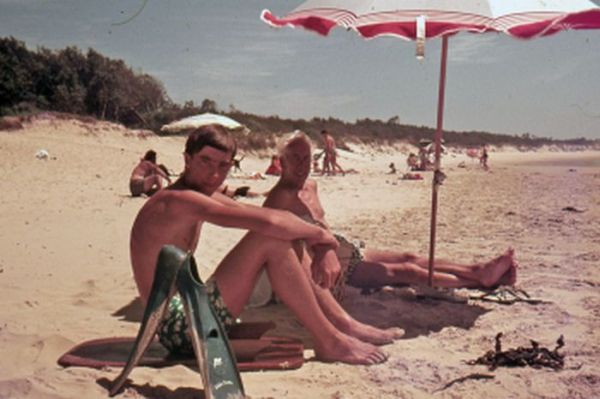
Photo courtesy of Dave Andrews.
You had to be able to paddle as well?
All that. I tried mals a few times, went over the falls a few times.
Did all that stuff and made everybody laugh in the pre-leg rope days. I
was too impatient and could not waste time to learn - when that time
could be better spent body surfing, something that I could already do
and enjoyed.
2. Where did you get the idea for a bellyboard?
At that stage I used to body surf at every
chance when at the coast. Coffs Harbour used to have a hall, pretty
much opposite the carpark where the main town centre is. They used to
have surf movie nights during the holidays. They'd put on the latest
surf film and we'd all go there and watch it.
I can remember getting driven into there and saw a film that had George
Greenough in it. He was riding surf mats and all sorts of stuff, even a
pump-up air bed or something at one stage, in quite big waves up around
Lennox, I believe. I think in that film or one of the films somewhere
there was someone riding these bellyboards. I was trying to think where
I got the idea because I'm an "inland" person and did not have long
exposure to the surf scene at the time. Maybe I just made it from my
own thoughts at the time.
3. Did you make the board yourself?
I used to make my own canoes. I started making
them out of sheet metal and timber. Then I was making them out of
marine ply. I thought, "I'll make one of these bellyboards." I made two
of them. I was born in 1952. I made the plywood canoe when I was about
14, so I reckon I was about 15, when I made the bellyboards.
Dave's
bellyboard.
|
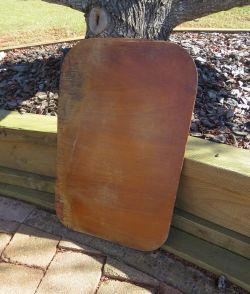
|
|
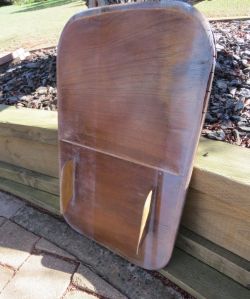
|
Photos courtesy of Dave
Andrews.
So that would be 1967?
Say 1966, a bit earlier?
Maybe that would help date the Greenough movie?
I don't know when I made the second one. I think the second one was a
bit heavier, like a bit thicker. Every time I went to the coast I'd use
it all the time. I'd use it, use it, use it. It was really fast in the
bigger waves, in the bigger steeper waves.
This was the heavier board?
Yeah, the heavier one that you saw [from a photo of the board in a surf
shop—see question 7].
How did you make the board?
I would have cut the shape out with a hand saw and a fret saw, I
reckon. I had a hand plane. I would have foiled the front out with the
hand plane and I had a mallet and chisel. Sand it up and varnish it.
How thick is the board?
The board is 5/8 of an inch thick. The other one was 1/2 inch thick. A
guy used to make furniture in the town and he used to give me all these
off-cuts of wood that I made things out of. I think I scavenged it out
of his bin and just made it.
When I saw the photos the fins looked newish whereas
the bottom looked really worn. Did it originally have fins on it or
were they added later?
I must have used the board a fair bit because it's got a lot of wear on
it. What it is, the top is worn. It was actually in my old caravan
which leaked so it is water damaged. A guy painted the caravan but
didn't take the board out from underneath the beds where the boards
were stored. That's actually overspray. I started to clean it off but
someone said, "You should leave it as it is." When that's cleaned off
it comes back as an estapol-type finish. The fins were always in it.
Bellyboard fins.
|
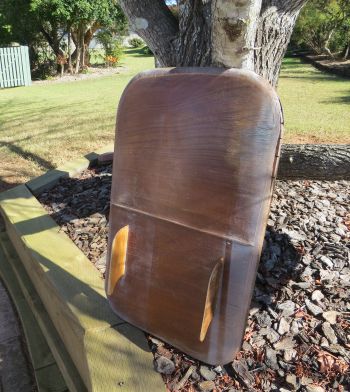
|
|
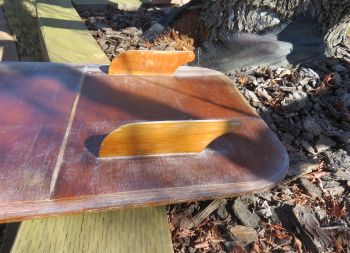
|
Photos courtesy of Dave Andrews.
The fins were always on it and were made from off-cuts from a sheet of
3/16 inch marine ply left over from a canoe project prior to 1966. The
cost of an 8ft x 4ft sheet of 3/16 inch marine ply at the time was an
expensive 3 pounds 16 shillings - pre-decimal currency that was
introduced in 1966.
How did you fit the fins?
I don't know exactly, but hand fitted. We didn't have many tools at the
time, only hand tools. We didn't have a router or anything.
Bellyboard
design drawings.
|
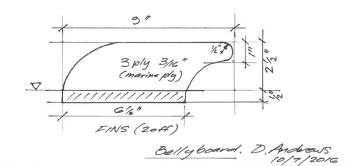
|
|
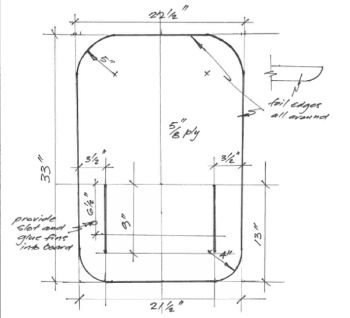
|
Drawings by Dave Andrews.
Some people used screws?
No screws in it. I cut the slots out with a chisel and a mallet and
it's probably been glued in with "Tarzans Grip," or something similar.
There were hardly any other glues around then that were waterproof. The
accuracy of those slots the fins are in - I couldn't do it now! I was
surprised when I got it back out and had a closer look at it. The glue
is still intact, no cracks.
4. How did the board surf?
It was really, really fast compared to body
surfing. What was good about it, because while it floated, it only just
floated. In bigger surf you could just duck-dive easily with no
buoyancy to provide resistance. When you got down deep enough you just
pulled it at right angles to the water body and hold onto it, and it
couldn't suck you back out. You know, when you have a big surf it picks
you up anyway when you don't go deep enough? Once the swell was gone
you could just pop up. It had no keeper on it at all so if you got
really smashed, you'd come up and you'd wonder where it was. You find
it and off you'd go again.
So did you ever see similar boards.
No, I can't remember seeing anything similar.
So basically you had to work out how to surf your
board on your own?
Yeah, because I could body surf really well, I had a pair of
skin-diving flippers, I just adapted.
Were they Turnbull fins?
The blue ones, that were quite long. Regularly lost one or both as I
didn't use keepers (not cool!), but they floated to a certain extent.
(I also used Voit, but they were not as good.)
I realized I could actually go along the wall of a wave bodysurfing
when I used them. When I got the board I could really hammer along. I
got covered a couple of times but it was only very short, but exciting.
What technique was involved - would you take off and
just hold an edge?
That's basically it. You couldn't turn that much. You didn't do that
stuff in those days. You took off and went as fast as you could along
to beat the wave. You didn't do the stuff they do these days, go off
the top and aerials and all that. If you did catch something big and
you got pitched forward it was a pretty hard thing to land on. It had
to be a fairly steep wave to operate on.
What happened if it was fuller?
You could catch them but you didn't get the planning speed. The board
is fairly short--it came down to the top of your thighs. It really only
just made your chest broader - you know how you hunch your shoulders to
get a bit more air coming into your chest when you body surf, to make
your body plane a bit better? The board just made your body plane a bit
better. It made a difference. It was pretty good.
5. For how long did you ride the board?
I know I've got a photo and I've got a beard
then. I know I'd left school. I probably rode it until my early-20s.
So you would have ridden it for 8 to 10 years? I
checked a web-site and The Endless Summer was made in 1966 and The
Hot Generation in 1968.
It could have been Endless Summer, I reckon. It was around that
era. I was also, and still am, really inspired by George Greenough's
film, Inner Most Limits of Pure Fun. I've been around to Byron
and tried to get one of those "spoons" of that era. I am an engineer
and I was always fascinated by the way things planned. So he fascinated
me by what he did. The spoons he made were designed to actually flex.
It had a large fin in the bottom and the whole thing would flex. It was
like a horseshoe of foam with a fiberglass sheet between it. But I
didn't have the equipment to make anything like that so I made
something out of wood. It was a one-off. No-one else had one. I was
surfing by myself and had a ball on it.
Two Posters for
The Innermost Limits of Pure Fun.
|
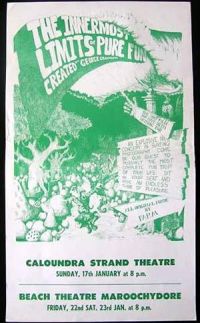
|
|
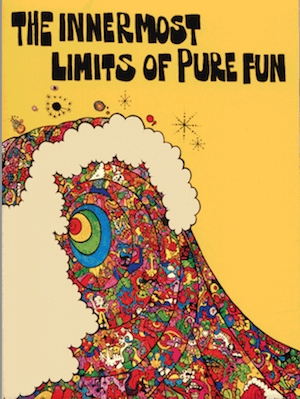
|
Sources: Moviemem and
Surfmovies.
Avalon was a place guys from Maroubra rode a similar
style of board, but often people were riding these boards in isolation
from one another.
I think we had 1 or 2 holidays at Avalon. I can remember staying at a 5
or 6 story block of units on the southern end of the beach. I dropped
a Super Ball (they were the latest fad at the time), it went over the
balcony and bounced about 4 storeys and went down the road bouncing
over cars. I just closed the door and went inside.
Avalon Beach is quite steep from memory. I can remember going out in a
really big shore break. I didn't have a wetsuit - from the bush! It was
only a fairly short beach and there were no board surfers there, but a
couple of body surfers with full steamers. A bit adventurous, but a
couple of good sessions all the same.
6. Where else did you surf your board?
I can recall surfing the main beach at Surfers
Paradise, Tugun, Kirra, Greenmount and Rainbow Bay on the Gold Coast.
Kirra was an issue as the timber board wasn't allowed in the area where
the black rubber hired Surf-o-Planes were. Almost confiscated!
Also surfed a lot at North Sapphire on the Coffs Coast. Also McCauleys.
There used to be a little inlet that had a big rock, shalely beach that
was very narrow. Big swells used to come in there. It was really
exciting but only a short wave.
Was that north of McCauleys?
North of McCauleys I think. It was just an inlet. It was crazy to go
out. We used to go there and have a bit of a go. We surfed North
Sapphire when all the land around was banana plantations - all houses
now. There was a bombie out there off Sapphire that used to break in
the bigger stuff. We used to flap our way out there and have a go out
there, too. It's quite a way out. Probably a 100 metres off the beach.
It needs a bigger swell to work. It was only short and pretty wild.
Just crazy when I look at it now. You'd come out with blood on your
hips from the board impacts.
It's good to hear you had so much fun on a simple
piece of wood.
I would go
places the guys on mals couldn't
go to. They were always sitting out wider trying to catch something big
and a bit fuller because they had trouble taking off on the steeper
sections. I could sit right in close to the rocks really, just paddle
in close and pick up steep little waves where I really shouldn't have
been.
Dave's
bellyboard.
|
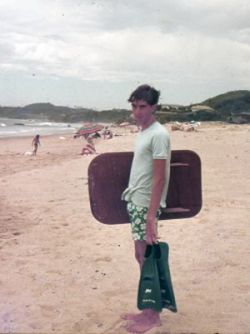
|
|
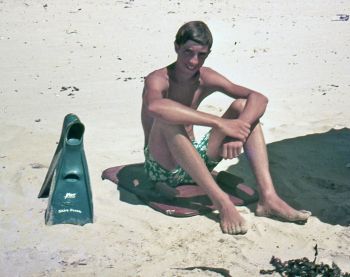
|
Photos courtesy of Dave Andrews.
Mals back then weren't suited to steep hollow waves.
No, so you didn't have to worry about them because they weren't there
where I was surfing.
When leg ropes came in and boards got shorter you
would have no longer had an advantage.
That's right. The short board revolution completely changed surfing at
that time. They were a lot faster and I still enjoy watching good
surfing, particularly at Snapper Rocks - still go there and paddle out
into the crowd.
Being inland and having three weeks at Christmas at the caravan park at
North Sapphire, or somewhere, I'd surf flat out for the three weeks.
Virtually 12 months of surfing in three weeks.
At that time you had to walk over the headlands because it was all
banana plantations. You'd walk over to this beach that had no one on it
- how good was that! The other beach was in front of the Sapphire
Gardens caravan park, which was north of the Banana Bowl, another
caravan park, where the Opal Cove is now.
7. In your twenties did you take up some other form of
surf craft or did life take over?
I got a job in Armidale. Then I got into
motorcycle trials and raced enduros at a competitive level. Married,
kids, etc.
After moving to Grafton in the early-1980s, we were still having family
holidays on the Gold Coast at Rainbow Bay at the time when wave skis
came onto the market. I said, "I've got to have one of these." It
combined distant past canoe skills and surf skills, finding the thrill
of being close to the water and going faster was an attraction. I
bought a "Dart" ski in the mid-1970s, and have ridden wave skis ever
since. I've had a series of skis over the years of different makes and
have got a custom made one now, a Wave Master by Col Samways,
out of Broadmeadow. Goat boats are a bit out of date now but still
heaps of fun. A couple of my best mates are top mal riders and are good
to surf with, but I am impressed with the body boarders that get inside
next to the rocks........
The bellyboard just stayed in the caravan over the years. I recently
sold the van but thought I'd better keep the board as it is a bit of
"history." I had it down the Plankshop at Yamba on display just to
create some interest. When that shop closed down around Easter 2016, I
bought it up to Noel Smith's Low Pressure surf shop in Grafton. I
thought I may as well display it in with the body boards as an item of
interest - to help sell one for him when people saw where they came
from. It's uncannily like the boogie boards that came out with fins on
them in the 1970s.
Dave's
bellyboard in Noel Smith's Low Pressure surf shop. A well used board.
|
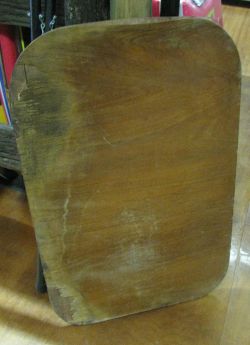
|
|

|
Photos by Ian Anderson.
So did you only keep one of your boards?
I don't know what I did with the other one. I do have a photo of the
later board, with it under my arm and a pair of flippers at Sapphire
Beach in 1967. I haven't got any photos of me using it though as you
need a telephoto lens for that type of photography - just happy snaps.
Dave, ski and bellyboard.
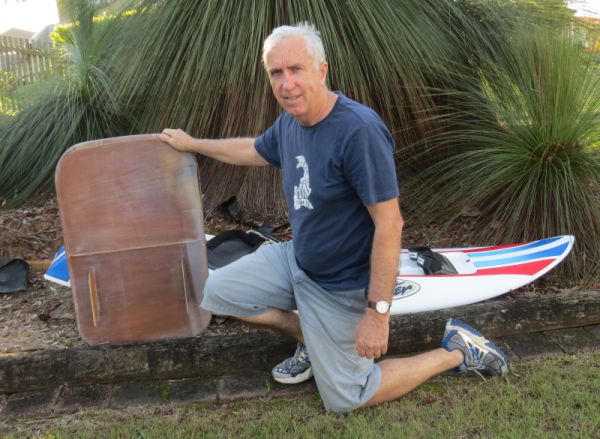
Photo courtesy of Dave Andrews.
I might make another bellyboard one day. There are lighter timbers now.
On the north coast we have magnificent timbers. I have had some
furniture made out of a timber called flooded gum. It's a light
coloured timber and as light as anything. It's a hardwood but as light
as you can get it. If you made a board out of it, it would be half the
weight that board is. Those big flippers I had, my legs would cramp now
with them, but I have a pair of short fins that I occasionally use when
not on the ski.
Keep smiling!
|
|